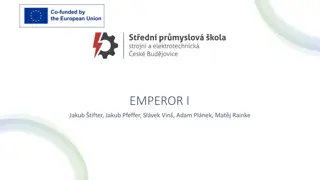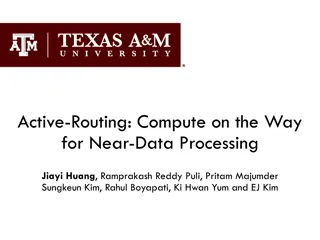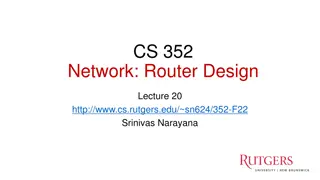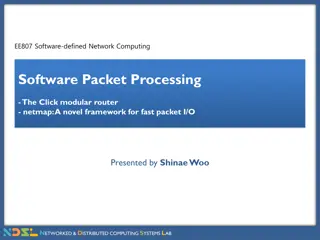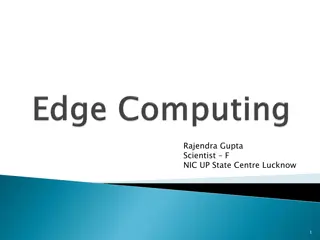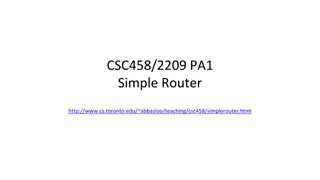Unleashing Router Processing Power: A Revolutionary Approach
Delve into the realm of router processing power optimization with Marat Radan and Isaac Keslassy as they propose tapping into unutilized resources. Explore the innovative concept of redirecting packets to alleviate congestion and maximize efficiency in network operations.
Download Presentation

Please find below an Image/Link to download the presentation.
The content on the website is provided AS IS for your information and personal use only. It may not be sold, licensed, or shared on other websites without obtaining consent from the author.If you encounter any issues during the download, it is possible that the publisher has removed the file from their server.
You are allowed to download the files provided on this website for personal or commercial use, subject to the condition that they are used lawfully. All files are the property of their respective owners.
The content on the website is provided AS IS for your information and personal use only. It may not be sold, licensed, or shared on other websites without obtaining consent from the author.
E N D
Presentation Transcript
Tapping Into The Unutilized Router Processing Power Marat Radan (Technion, Israel) Joint work with Isaac Keslassy (Technion, Israel)
Introduction: Typical Router Architecture Switching 2
The Processing Revolution Routing (header processing) 2 orders of magnitude computational complexity Payload processing: payload encryption, intrusion detection, worm signature generation and more. Nearly-unbounded computational complexity Network programmability Data centers and VMs (Virtual Machines) SDN (Software-Defined Networking) NFV (Network Function Virtualization) C-programmable applications We need more processing power! 3
Outline Model Assumptions and Valiant The Infinite Switch Fabric Models Infinite capacity Single queue N-queues Example Simulation 4
Generic Router Model Focus on the ingress path 5
Generic Router Model Simplify the ingress path Processing 7
Generic Router Model Drop packet Congested 8
Our Proposal Redirect part of the packets to a less congested linecard Our proposal Congested Unutilized processing power Our idea: Tapping Into The Unutilized Router Processing Power 9
Model and Assumptions Find optimal redirect probabilities 10
First idea: Valiant-based Algorithm P=1/3 P=1/3 P=1/3 Inspired by: 11
First idea: Valiant-based Algorithm P=1/3 P=1/3 P=1/3 Inspired by: 12
Capacity Region N=2 N=10 N Number of linecards 13
Related Work - GreenRouter Change router architecture, two SF layers Separate processing and interface in linecards Y. Kai, Y. Wang and B. Liu, GreenRouter: Reducing power by innovating router s architecture , 2013. 14
Outline Model Assumptions and Valiant The Infinite Switch Fabric Models Infinite capacity Single queue N-queues Example Simulation 15
The Single Queue Switch Fabric Model Shared Memory Switching Delay 17
The N-Queues Switch Fabric Model Output Queues 18
Outline Model Assumptions and Valiant The Infinite Switch Fabric Models Infinite capacity Single queue N-queues Example Simulation 19
The Single Queue Switch Fabric Model Shared Memory Switching Delay 20
The Single Queue Switch Fabric Model - Optimization Average delay Flow conservation Feasible SF flow Positive flow Feasible linecard flow Positive variables 21
The Single Queue Switch Fabric Model - Intuition 3 1 2 1 Minimal average delay optimality conditions, redirect from i to j: Linecard i weighted delay derivative Linecard j weighted delay derivative Switch fabric weighted delay derivative 22
The Single Queue Switch Fabric Model - Example Complexity: 23
Outline Model Assumptions and Valiant The Infinite Switch Fabric Models Infinite capacity Single queue N-queues Example Simulation 24
The Simulation Model - Decision making algorithm The processing time is calculated based on the packet size using the number of instructions and memory-accesses estimate of PacketBench Input-queued switch fabric with VOQs and an implementation of the iSLIP scheduling algorithm. for header and payload processing applications. The architecture remains constant through the simulations. Real high-speed Internet backbone link traces from CAIDA. Each input is associated with a different trace. Only the load-balancing algorithm changes. 25
Real Traces, iSLIP, PacketBench +25% capacity Simulation settings: Five linecards with ~24% OC192 utilization, five with ~3%. Each linecard is associated with a different trace. Note: Link utilization Processor utilization 26
Real Traces, iSLIP, PacketBench Simulation settings: Five linecards with ~24% OC192 utilization, five with ~3%. Each linecard is associated with a different trace. Note: Link utilization Processor utilization 27
Concluding Remarks Invented way of tapping into the unutilized router processing power Significantly extended capacity region Lower delay Reasonably higher complexity 28
THANK YOU! 29














